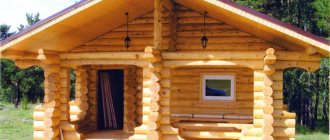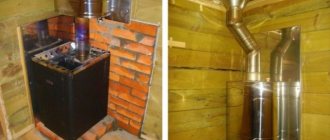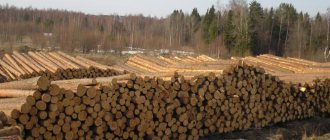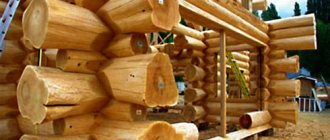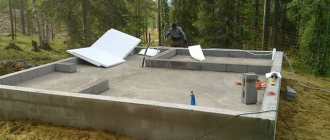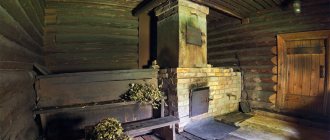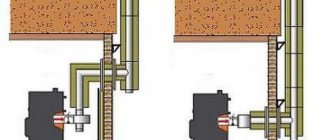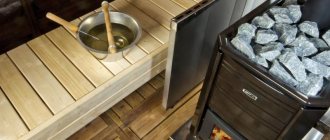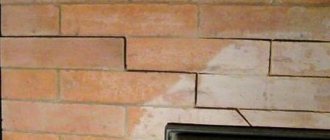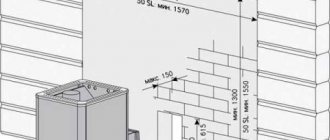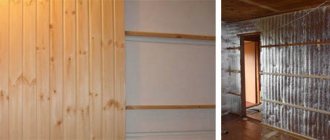I cordially greet you, dear readers!
Warmth in the home is the main component of comfort. Neither fashionable furniture, nor branded accessories, nor stylish finishing materials can allow you to enjoy comfort if the house is cold. Therefore, today there is a huge number of different heating systems. In multi-storey buildings there is central heating, which is in excellent harmony with additional or alternative heat sources.
In private homes, these are mainly boilers used only in combination with high-quality chimney systems. They are made from different raw materials, but, unfortunately, or fortunately, traditional pipes are inferior to innovative equipment.
For example, a coaxial chimney is in great demand. The equipment is new, but has already acquired numerous enthusiastic admirers. Why is it wonderful and what is the secret of success? But let's find out.
Design selection
The first thing you need to decide when choosing a chimney is where to install it. There are few options. It can be entirely indoors and go vertically outside through the roof. Or it can be brought out horizontally through the wall and rise up from the outside.
Each option has both advantages and disadvantages that will affect the choice of chimney location.
Internal chimney
The traditional and more familiar way of installing a chimney is inside the bathhouse, vertically upward from the stove, which ensures maximum draft. Passing the entire distance to the ceiling through the pipe, the hot smoke becomes an additional source of heat, so the bathhouse heats up faster, and less firewood is required.
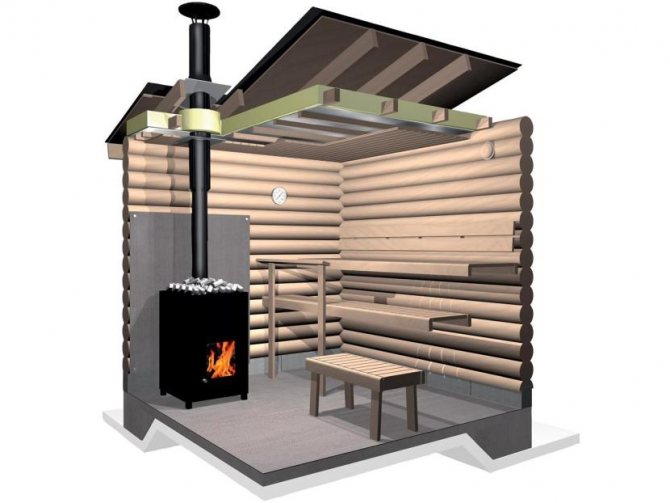
Bathhouse with internal chimney Source rakentaja.fi
Its main disadvantage is the complexity of installation, since the pipe passes through two structures at once - the ceiling and the roof. And the passage units must not only provide protection for their elements from the hot surface of the chimney, but also be sealed so as not to let precipitation inside.
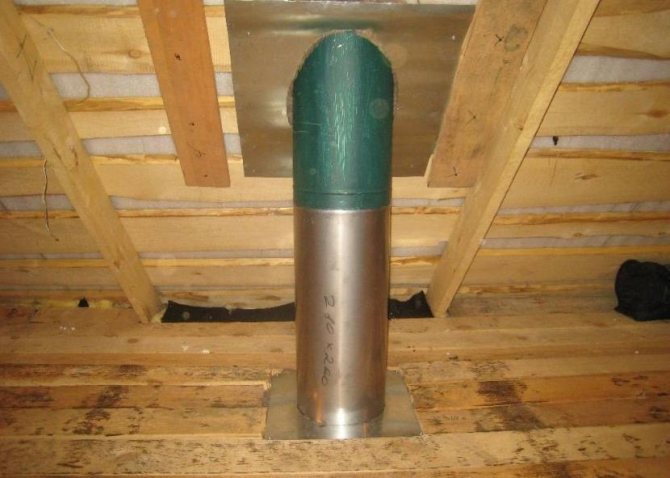
Pipe passage through the roof and ceiling Source sdelai-lestnicu.ru
Another disadvantage is that the chimney takes up a certain space. This can be critical for small rooms, both by reducing the usable area and by increasing the risk of getting burned from the hot surface of the pipe.
However, an additional advantage of the internal chimney is the ability to install a tank for hot water on it, which will heat up, taking heat from the walls of the pipe. Such a tank is called a “samovar”. It can only be mounted on a chimney for a stainless steel bath; in this case, you don’t have to choose which pipe material is better - metal heats up more than others, and it’s only possible to ensure the tightness of the tank.
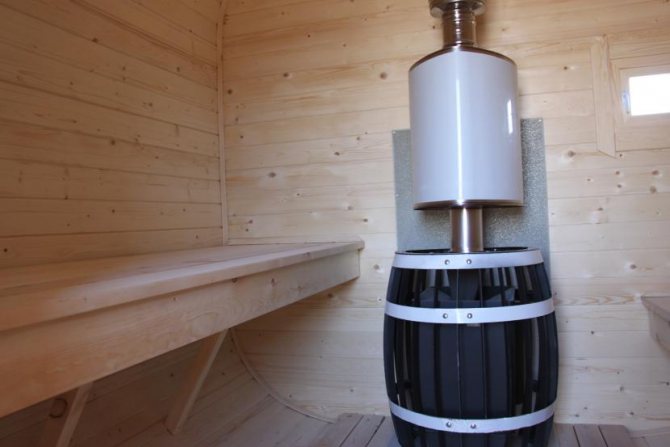
Stove with a samovar tank for hot water Source e-stroy.pro
External chimney
A chimney that immediately goes outside from the stove through the wall is not the best solution for latitudes with cold and long winters. A huge amount of heat that could remain in the bathhouse is immediately thrown out into the street. And this leads to additional fuel consumption and increased time for heating the premises.
In addition, when hot gases come into contact with the cold walls of the pipe, condensation forms on them. Soot and other combustion products settle on a wet surface, clogging the passage and gradually narrowing the lumen of the pipe. To prevent this from happening, its outer part must be insulated.
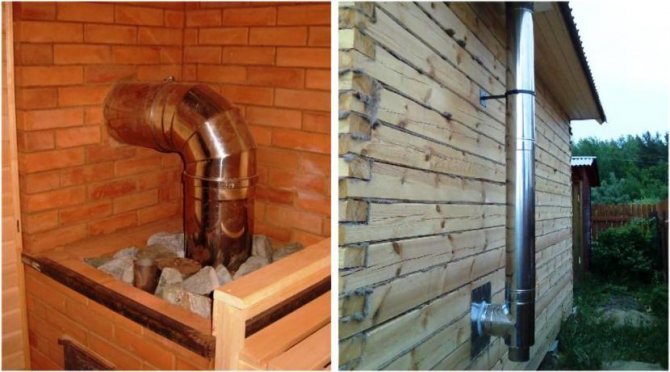
External chimney - view from inside and outside Source vosaduly.ru
But this solution also has significant advantages:
- ease of installation - there is only one pass-through unit, through the wall, and it is easier to make;
- maintaining the usable area of the steam room;
- reducing the risk of smoke and fire inside the bathhouse in the event of damage or depressurization of the chimney;
- availability of all components for inspection and repair.
Combined option
External or internal pipe for a bathhouse - which one to choose will be determined by the size and layout of the heated premises, as well as personal requirements for fire safety, fuel economy, and ease of installation.
If you don’t want to touch the roof, but want to install a samovar tank in the bathhouse, you can use a combined design, where the pipe rises up almost to the ceiling and then goes outside through the wall. But the height of the ceiling must be sufficient for such a maneuver - a fire distance must be left from it to the horizontal part of the pipe.
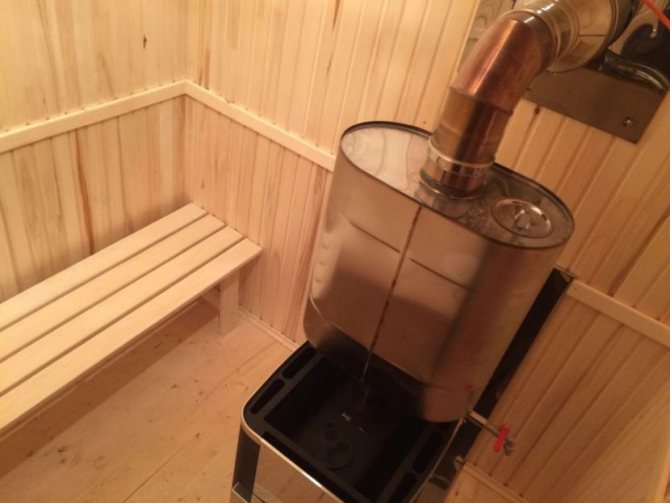
In a combined design, the pipe goes out to the street at the top of the wall Source demyan-pechi.ru
Note! The fewer turns the chimney has, the better the draft. In terms of this parameter, direct internal chimneys connected to the stove from above win.
Operation
So, what is the principle of operation of the device?
The operation of a coaxial chimney for gas boilers is based on the counterflow principle.
The process looks like this:
- air mass is taken from the street;
- the air mass moves through the outer pipe;
- the air mass is heated from the inner pipe;
- the already hot air mass enters the closed furnace of the boiler, which promotes better combustion of gas (remember a regular blowtorch).
As you can see, there is nothing supernatural. Everything is extremely simple, but effective.
Choosing material for making a chimney
Chimneys are made from a variety of materials, from traditional brick to heat-resistant glass and ceramics. They are chosen based on practicality, financial capabilities, fire safety requirements, appearance and many other factors. For example, when deciding which pipe is best to put on an iron stove in a bathhouse, it is unlikely to be logical to consider a heavy brick chimney. Although this option is also possible. Therefore, it is worth studying in detail all existing types of chimneys, their pros and cons.
Brick
A brick chimney has excellent heat capacity - it remains hot for a long time after the end of the firebox, releasing heat into the surrounding space. At the same time, the outer surface of the pipe does not heat up so much as to cause a fire in the adjacent structures. You can also note the safety for health (when heated, the brick does not emit harmful substances) and the visual attractiveness of such a pipe.
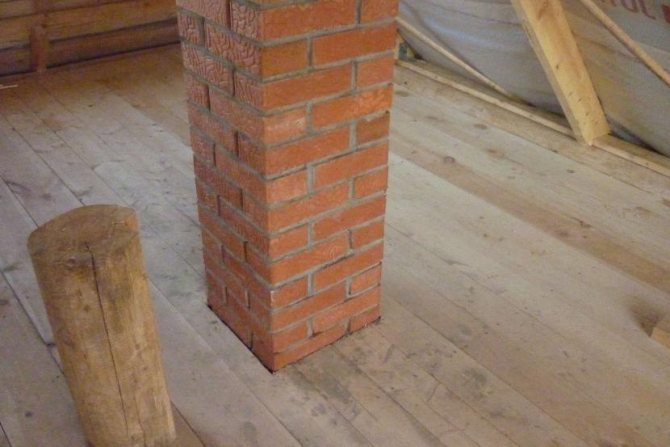
The thickness of the walls and the non-flammability of the material make it possible not to construct a fire protection unit when the chimney passes through the ceilings Source mybuilding.tips
However, today this material is not as popular as it used to be, when the choice of chimneys was small. Brick pipes have many disadvantages compared to them.
- Heavy weight. The brickwork has an impressive mass, so such a chimney requires the construction of a durable concrete base buried in the ground.
- Incompatible with modern metal stoves. The brick pipe cannot be placed on the stove; it is laid out separately and connected to the firebox by an outlet pipe.
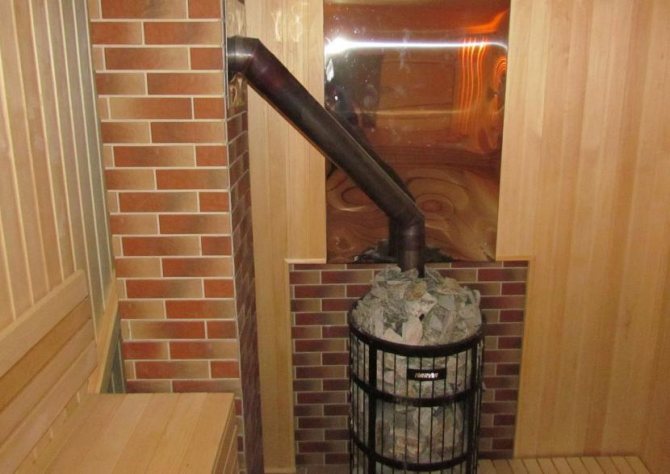
See also: Catalog of companies that specialize in fireplaces, stoves and utilities
- Frequent cleaning required. The rough surface of the internal walls and the rectangular cross-section of the pipe lead to the fact that deposits of wood combustion products quickly build up in it.
- Difficult to install. Carrying out brickwork requires experience to ensure that the structure is smooth, with as smooth walls as possible and well-made seams through which smoke should not leak.
Considering all the advantages of brick chimneys and the problems associated with their installation and operation, such structures are chosen primarily for the installation of brick sauna stoves, which are always placed on a foundation. But even in this case, they are often sleeved, installing steel or asbestos pipes inside the masonry.
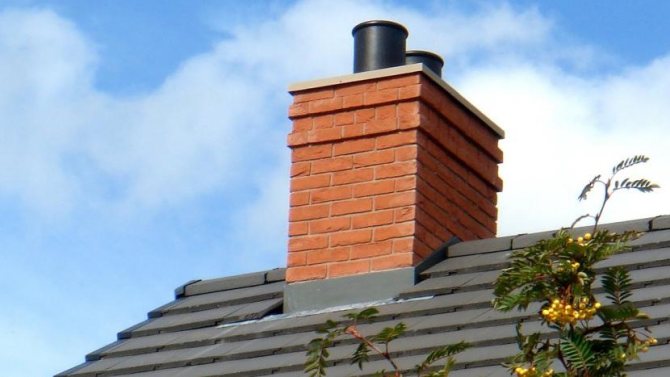
Through a pipe with a round cross-section, smoke escapes faster, without turbulence Source blogspot.com
Ceramics
Like brick, ceramic chimneys are not afraid of high temperatures, acids, alkalis, and moisture. But they also have a lot of weight and require a support base. And if you choose which is better, a brick or ceramic pipe for a sauna stove, then preference should be given to the latter - the round cross-section and smooth surface do not allow soot and street dust to settle and accumulate on the walls.
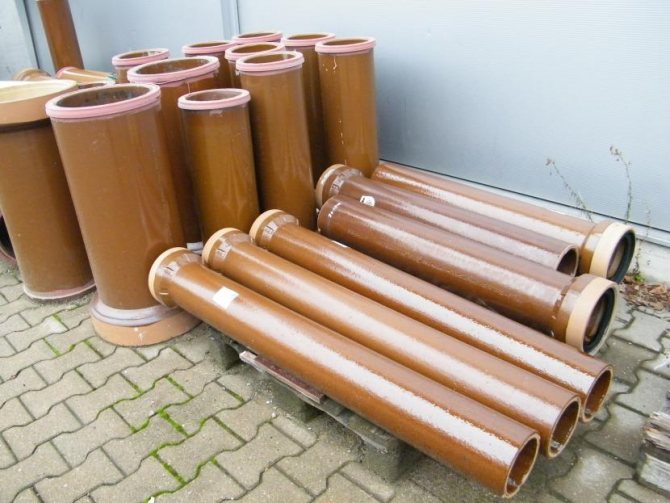
Ceramic pipes for chimneys Source wikimedia.org
This is an ideal option for a bathhouse, which is most often rejected for three reasons:
- very high cost;
- the need to fill the foundation;
- occupied by a chimney installed on the floor next to the stove, the useful area of the steam room.
The pipes themselves do not weigh so much that they cannot be installed directly on the stove. But they are mounted inside special concrete or ceramic blocks that have a large mass. These blocks protect rather fragile thin-walled ceramics from mechanical damage and serve as a frame for laying thermal insulating shells made of basalt wool around them. This design of the chimney eliminates the appearance of condensation in it.
Depending on the type of external blocks, the ceramic chimney can be made single- or double-channel. This is convenient if you need to combine the smoke exhaust system from two stoves. But such a need usually arises only when arranging large baths with many isolated rooms.
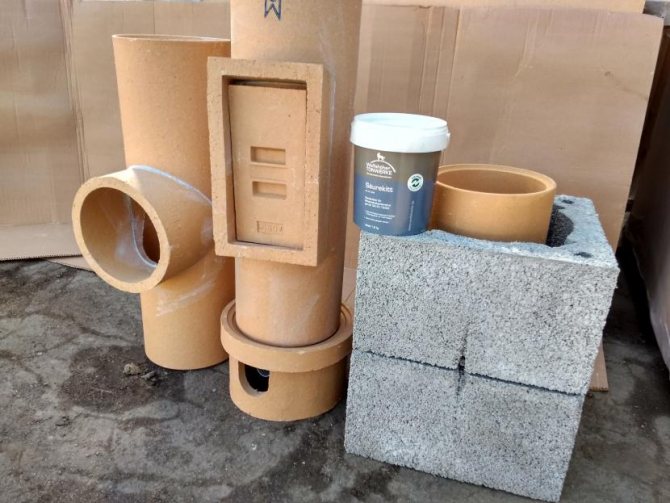
The kit may also include shaped connecting elements and special compounds for assembling and sealing the chimney Source gromasstroy.by
Glass
If we talk abstractly about a chimney for a bathhouse - which one is better to choose, so as not to think about the need for repair and cleaning, and not to be afraid of fires and smoke leaks, then the most correct solution would be a pipe made of heat-resistant and impact-resistant glass.
But it will cost a very decent amount, since both the material itself and the installation of a glass smoke duct cost a lot of money. And finding a specialist capable of professionally performing this work in our country is still almost impossible.
Asbestos
This option cannot be recommended for indoor installation on a sauna stove, since asbestos releases toxic substances when heated. Such pipes can be installed during external installation of chimneys, using steel adapters to connect to the firebox and pass through the wall.
But you need to understand that cheap asbestos pipes will not last long, since their porous surface will absorb moisture, which expands when freezing and causes destruction of the material. In addition, soot will quickly accumulate on their walls, and cleaning the channel using mechanical methods can be disastrous for fragile walls.
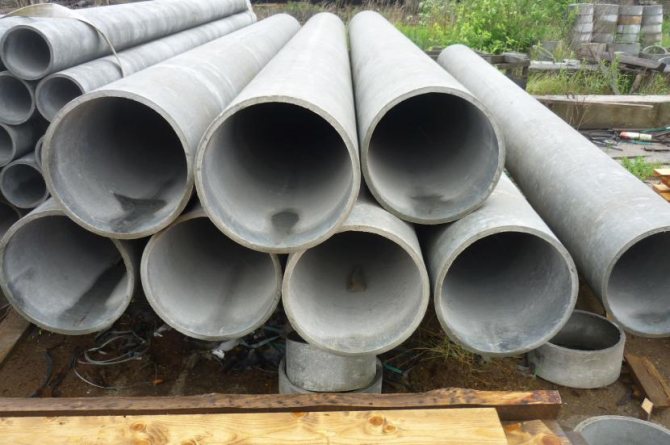
Inexpensive but unreliable asbestos pipes Source mtv-plus.rf
Advantages
So, what are the advantages of a coaxial chimney system?
The advantages of the innovative device are:
- long service life - life expectancy more than 50 years;
- resistance to wear – the system resists the destructive influence of climatic, mechanical, biological, thermal factors;
- practicality - the structure does not pass through the roof, so there is no need to violate its integrity;
- safety - the risk of fire in the area of contact of certain flammable surfaces with the smoke exhaust system is reduced, since the internal pipe is perfectly cooled by the external one;
- environmental friendliness - the smoke exhaust promotes complete combustion of fuel, so the number of unburned particles emitted into the air is significantly reduced;
- efficiency - there is no need to organize additional ventilation, since substances harmful to the human body do not enter the home;
- compactness - the chimney has optimal dimensions, resulting in space saving;
- extremely wide range - choosing the right sample for a particular system is not difficult;
- efficiency - increasing the efficiency due to warming the incoming cold air mass on a heated pipe;
- easy installation - no special skills or knowledge required.
The advantages are impressive. Is not it? Let's move on to the disadvantages.
Selecting pipe parameters
To determine the amount of material for equipping the stove in the bathhouse with a smoke channel, you need to know its length and diameter.
Diameter
What pipe diameter is best to use for the chimney into the bathhouse is not an idle question; your safety and the normal operation of the stove depend on it.
We are talking about the internal cross-section of the chimney or the size of the lumen of the pipe through which smoke is evacuated to the outside. If there is a factory-made stove in the bathhouse, then it is easy to determine the required internal diameter of the smoke channel: it should be the same or slightly larger than the outlet pipe from the firebox.
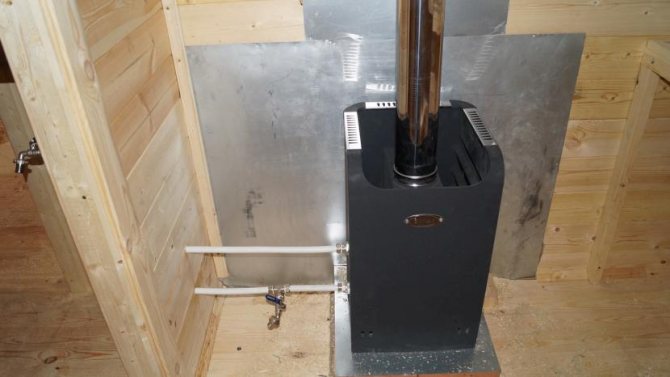
The outlet pipes have standard sizes, allowing you to accurately select a chimney pipe for them Source domizbrusa.by
Classification
So, what types of devices are there? There is the following classification of structures.
1.) Location. There are such devices:
- internal - laid in mines;
- external - located on the inside of the facade in order to avoid deteriorating the appearance of the building.
2.) Insulation. There are such devices:
- insulated - used in regions where low temperatures prevail for a long time;
- not insulated - used in areas where high temperatures reign for a long time.
3.) Output type. It depends on the location of the boiler in the room and the path along which the chimney is laid. There are structures with the following conclusion:
- vertical;
- horizontal.
4.) Amount of equipment. Options available:
- individual - intended to serve one boiler and do not differ in the presence of branches;
- collective – systems where individual branches are connected to a common channel.
As you can see, the choice is good and rich.
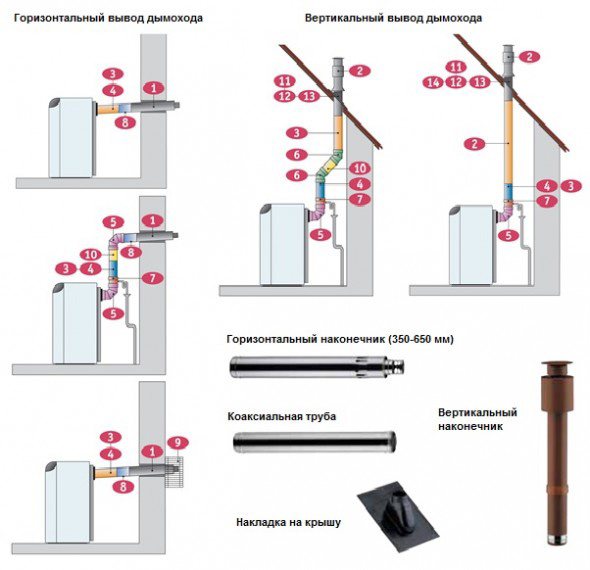
Video description
How to determine the height of the chimney, watch this video:
- If the horizontal distance from the ridge to the pipe does not exceed 1.5 m, it should rise 50 cm above it.
- At a distance of up to 3 m, the top of the pipe can be at the same level as the ridge.
- If it exceeds 3 m, then you need to draw a line from the ridge at an angle of 100 to the horizontal, and at its intersection with the vertical axis of the pipe installation the required height will be located.
- The length of the chimney above a flat roof should be 1 m.
Selection of components
It is not enough to simply choose which pipe to use for your sauna stove. For proper installation of the chimney and its safe operation, various components and consumables are required.
Even if your choice fell on an insulated three-layer sandwich pipe, installation begins with an uninsulated single-wall pipe, the task of which is to take the temperature of the gases leaving the furnace and release it into the room. Using an adapter, it is connected to the main chimney.
The set of components depends on the design and location of the chimney.
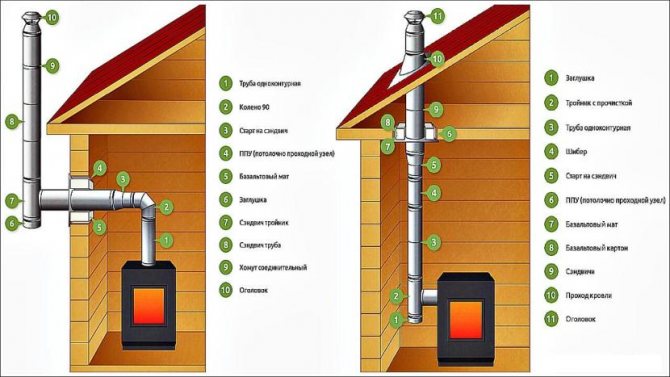
The main components of the external and internal chimney Source tvoya-banya.ru
A mandatory element of any design is a gate, which is a rotary or retractable valve mounted in a pipe. The damper handle extends outward so that it can be controlled by adjusting the draft.
To rotate the pipe or bring it out through the wall, you will need an elbow with the desired rotation angle. A cap in the form of an umbrella or a reflector is installed on the top of the pipe to protect it from debris and precipitation getting into it and from blowing wind. And tees are used to collect condensate and clean the chimney.
For reference! To clean brick chimneys, holes are made in them, which are closed with metal doors.
Particular attention is paid to arranging the passage of pipes through walls, ceilings and roofs. In prefabricated structures, the kit includes a PPU - a ceiling-passage unit, which just needs to be installed correctly, following the instructions.
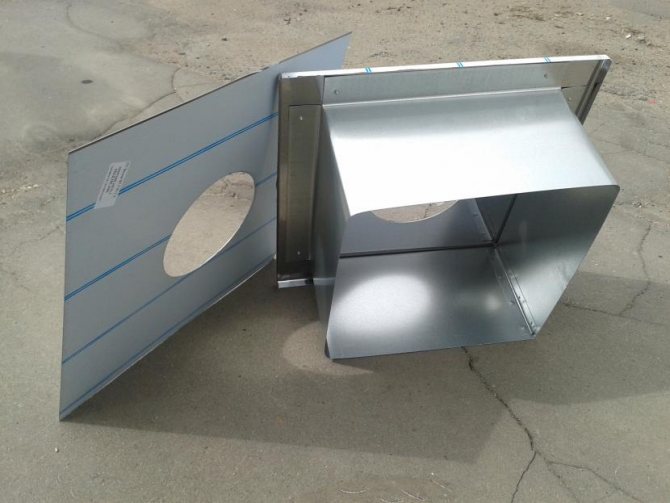
Ceiling pass-through assembly for sandwich pipe Source u-dacha.rf
Innovative device: general information
Concept
So, coaxial chimney: what is it? And this is a double-circuit structure, consisting of pipes of one diameter or another, which are located one inside the other. The design is assembled according to the “pipe-in-pipe” principle. Just don't confuse it with a sandwich. The main task of the external pipe is to supply street air mass, without which, of course, the combustion process is impossible.
But the purpose of the inner pipe is to remove combustion products to the outside. The sliding and contact of the device elements is prevented by special jumpers that are located in this design. The structure is intended for heating systems, which are distinguished by the presence of a closed combustion chamber.
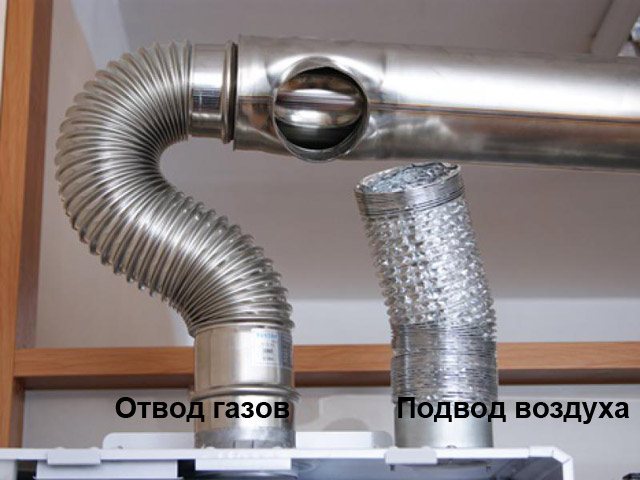
Design
So what is the design? The construction of the device cannot be called complicated. It consists of the following parts:
- an internal pipe made of stainless or galvanized steel with a diameter of no more than 80 mm;
- external pipe made of stainless or galvanized steel, cross-section up to 125 mm;
- an elbow that plays the role of a transition element during installation;
- an adapter designed to connect the boiler to the pipe;
- a clamp that provides high strength to the fastened parts of the structure.
As mentioned above, the material used to make pipes is galvanized or stainless steel. Both types are good. But it is preferable to use stainless steel pipes.
The standard set of parts can be supplemented with the following elements if desired:
- corrugated pipe - responsible for ensuring extremely quick and convenient installation of the pipe to the heating device pipe;
- decorative overlay (2 pcs.) – hides the entry point of the structure into the wall;
- flange designed for wall mounting of pipes.
As you can see, the system is simple.
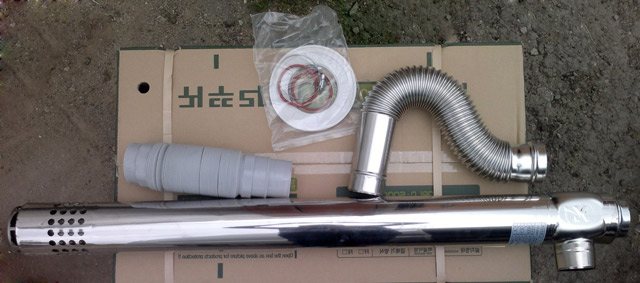
Selection by manufacturer
Those who prefer quality to an affordable price can be advised to buy products from manufacturers with a good reputation.
Steel chimneys on our market are represented mainly by domestic brands. Judging by the reviews, the products of the following manufacturers have the highest quality:
- Ferrum and Kraft (Voronezh);
- Baltvent (Kaliningrad);
- Termofor (Novosibirsk);
- Vulcan (St. Petersburg);
- Inzhkomtsentr VVD, Rosinox (Moscow region);
- Rosst@In (Russian Industrial Company) (Moscow).
But the production of ceramic chimneys in our country has not yet been developed. We produce only external blocks and insulation for fireclay pipes imported from European countries.
Installation of chimneys in Moscow and the Moscow region
Installation of chimneys is a complex technical process that requires certain knowledge and experience.
If the installation is carried out incorrectly, it can lead to disastrous consequences such as fire and carbon monoxide poisoning. That is why, for the service of installing chimneys in a house, you need to contact specialists who can complete the project efficiently. There are several types of chimneys:
- Attached (along the outer wall of the building);
- Direct (through the roof).
Each of them has certain nuances that need to be taken into account during repair work. Specialists are always ready to carry out installation of any complexity. The cost of installing a chimney in a private house fully corresponds to the quality of the service provided.
Video description
This video contains complete information about AVT chimneys, which are a product of such joint production:
Among similar products, it is worth noting the products of such joint ventures as:
- Shidel;
- Wolfshäuer;
- Ecoosmosis;
- Hymen.
Due to the fact that insulating elements and external blocks are produced locally and do not require transport and customs costs, the cost of chimneys of these brands is lower than that of completely European ones. But if you prefer completely imported products, then they are represented on our market by the following companies:
- Tona (Germany);
- Marshal (Czech Republic);
- Effe 2 (Italy).
Briefly about the main thing
The main questions when choosing a pipe for a bathhouse are which one is better, safer, more practical, cheaper, more durable. Each owner has his own requirements, so their choice may vary. First you need to decide where the chimney will be installed - inside or outside, and then select it based on the material it is made of. The most practical and durable option is ceramics, but it is also the most expensive. The cheapest pipe is made of ferrous metal, but it is susceptible to corrosion. The optimal solution is a modular chimney made from a sandwich pipe. Regardless of the type of pipe chosen, it is necessary to calculate its diameter and length and select component materials for installation and insulation.
Ratings 0
Scope of use
So, where is this miracle device used?
The scope of use of a coaxial chimney is extremely wide. It's flawless:
- for gas boilers;
- for gas convectors;
- for gas generators;
- for geysers.
Thus, the device is suitable wherever there are the above heat sources.
Attention! Quite often the question arises: “Is it possible to use an innovative device for a solid fuel boiler?” Remember, none of the existing solid fuel boilers CAN be equipped with a coaxial chimney. So, this topic is relevant only for gasified areas...
